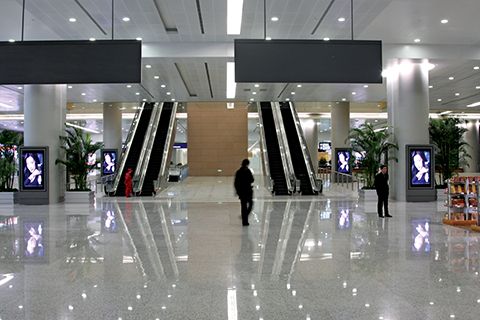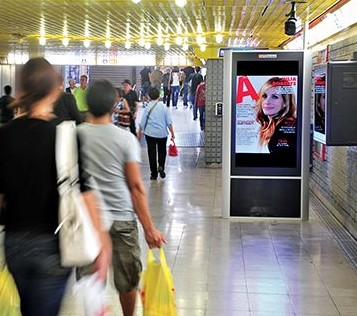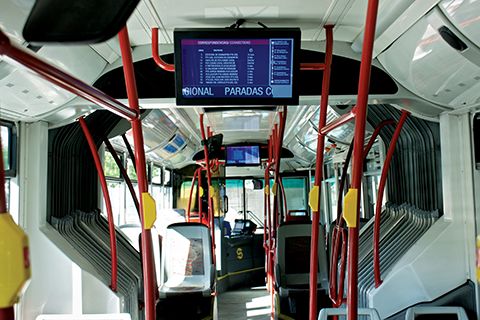Digital Signage: Transforming travel
by all | 27 March 2015 9:23 am
 [1]
[1]Photos courtesy YCD Multimedia
By Lou Carulli
In the days before digital signage, smartphones, social media and dedicated apps, travelling often involved a hectic, chaotic mix of paper schedules, maps and a lot of guesswork. Streamlining the process and eliminating as much confusion as possible for business travellers, vacationers, daily commuters and other travellers has long been a major priority for the transportation industry around the world.
Today, with the integration of digital signage and other technologies, there are many cases where travellers—both local and long-distance—are reaping numerous benefits.
Airports
Most travel hubs, but especially airports, are known for being confusing and stressful facilities to navigate. Digital signage has been implemented throughout many airport terminals around the world in an effort to reduce these negative factors and help provide an orderly, structured visual system that allows travellers to get important information with a minimal amount of effort.
The majority of these digital signage displays are designed to integrate seamlessly into the existing structures of the terminals, providing easy access to information at key navigational points along a traveller’s path in a fast, modern and efficient fashion. This integration is accomplished in a variety of ways, from large overhead screens for ease of visibility to smaller information kiosks that serve as user-friendly interactive stations. Useful content displayed on these digital signs includes not only flight arrival and departure times and gate numbers, but also weather reports and special alerts.
In addition to assisting travellers with wayfinding information and orienting them to the layout of a large terminal, digital signage has been shown to decrease their perceived wait times in lines, allowing them to relax. Even when shopping and dining at the airport, they will feel less stress knowing they can check the nearest screen for all the information they need.
Zurich Airport in Switzerland is one of Europe’s important international gateways and has often been considered one of the finest airports in the world. When the time came to implement digital signage, the airport’s in-house team decided to create their own network. They used content distribution and management software to send information to more than 100 screens installed throughout the airport terminal’s departure and arrival zones, as well as 34 synchronized screens in the baggage claim area.
In addition to providing travel information for passengers in a hurry, Zurich Airport’s digital signs feature co-ordinated advertising, along with entertainment and ‘atmospheric’ content to enhance the environment for travellers.
 [2]
[2]Shanghai’s Pudong and Hongqiao International Airports use digital signage software that broadcasts from a single computer, so only one content manager is needed to monitor a network of more than 200 displays.
The main network has provided a foundation for further communications. In the airport’s Upperdeck restaurant, for example, 28 flat-screen displays in horizontal (landscape) mode have been installed in one seamless row. They provide real-time flight information and entertainment for travellers who do not want to have to leave the comfort of the restaurant to visit a kiosk, but still want to keep track of their travel schedule. And in keeping with the restaurant’s travel theme, the screens also give customers a bird’s eye view of a variety of global destinations with atmospheric content.
In Mumbai, India, meanwhile, Chhatrapati Shivaji International Airport also uses digital signage to meet travellers’ cultural needs. In addition to the usual content mix of travel information, news headlines, weather reports and live TV broadcasts, the airport showcases astrology forecasts for its many Hindu travellers.
Further, passengers aren’t the only ones benefiting from the adoption of digital signage in airports. The medium is vastly beneficial to administrative staff, too, as it can centralize and simplify ‘omni-channel’ information, including facility-wide public service and security alerts, and thus reduce operating costs while increasing safety. The goal of an omni-channel approach is to connect many different types of device outputs to a single management platform, built into the facility’s existing information technology (IT) framework. This way, all display devices can be managed from a single point.
For the airport employees who need to manage these digital signage networks, there are many options today that make it easy to approve, upload and broadcast content online, either to the entire terminal-wide system or to targeted zones with focused messages. In China, for example, Shanghai’s Pudong and Hongqiao International Airports have implemented software allowing staff to broadcast eight content channels from a single personal computer (PC), so only one content manager is needed to monitor the system.
Moreover, the digital out-of-home (DOOH) advertising system used at these two airports enables synchronized playback, so images can move from screen to screen as people walk past them. More than 250 concurrent, targeted and synchronized content channels are available to any of the more than 200 displays in both airports, at any size, resolution or configuration. This setup allows ads to be extremely dynamic and engaging, yet keeps management simple.
 [3]
[3]A network of 40 LCD ‘totems’ at Milan’s airports was so well-received, it led to similar displays being installed in the city’s subway system.
Indeed, airports have been among the most successful venues in terms of generating sufficient DOOH advertising revenue to make their digital signage networks nearly self-sustaining (see Sign Media Canada, September 2014, page 46). Their terminals present a strong, high-visibility opportunity for advertisers to reach a broad audience.
In Turkey, for example, six high-definition (HD) video walls at four airports—including Istanbul Ataturk Airport’s international terminal and Bodrum Airport’s, Izmir Adnan Menderes Airport’s and Dalaman Airport’s domestic terminals—have successfully attracted advertisers because they are seen by roughly 60 million people every year. Fashion companies, banks and government ministries are among the advertisers that upload ads to the video walls and more than 100 other screens in the airports via the web.
Public transit
Airports are certainly not the only transportation venues that have used digital signage to improve efficiency
of communications and increase travellers’ comfort, but they have helped lead the way. In Milan, Italy, for example, a network of about 40 liquid crystal display (LCD) ‘totems’ at the city’s airports was so well-received for providing a positive service, staff at other transportation centres in the region began to take notice.
Soon, local officials decided to install similar displays in the city’s subway system. Their project saw 67 vertical (portrait-mode) LCD totems providing route information, delay notifications, public messages and ads.
Meanwhile, in Madrid, Spain, the main form of transportation for thousands of commuters and tourists is city buses, operated by EMT Madrid. With an increased awareness of digital signage, EMT administrators saw an opportunity for a pilot project to improve ease of travel, which can be challenging given the city’s many winding streets.
 [4]
[4]Digital signs in Madrid’s buses keep relevant with real-time content about the vehicle’s current locations, other connecting lines and upcoming tourist attractions.
The pilot involved 35 buses to test the effectiveness of the medium. Each bus was equipped with three screens in different seating zones, so content would be visible to all passengers. Then, in addition to displaying the buses’ timetables, weather forecasts, cultural event announcements and ads, the signs featured a map showing each bus’s current location—based on Global Positioning System (GPS) data—and information about other connecting bus lines. In this way, the screens would always be relevant with real-time content.
To further assist visitors, the signs also presented information about tourist attractions specific to each upcoming bus stop along the route. And all content was displayed in both Spanish and English.
Ubiquitous and diverse
In these ways, digital signage
is transforming the way people travel, all around the world.
By offering a single solution
to complicated, multi-faceted issues in chaotic, fast-paced settings, the medium has become perceived less as an amenity and more as a necessity. As such, more and more transportation organizations have invested in digital signage—and their numbers will only continue to increase.
At the same time, there seems to be no end to creativity and variety in the design and implementation of digital signage networks in the transportation industry. The options for customization are nearly limitless, making the medium highly versatile in different types of venues and facilities, no matter how passengers need to get from point A to point B.
Lou Carulli is marketing manager for digital signage software provider YCD Multimedia. For more information, visit www.ycdmultimedia.com.
- [Image]: http://www.signmedia.ca/wp-content/uploads/2015/03/upperdeck_restaurant_Zurich_Airport_4.jpg
- [Image]: http://www.signmedia.ca/wp-content/uploads/2015/03/Shanghai_Airport_1.jpg
- [Image]: http://www.signmedia.ca/wp-content/uploads/2015/03/Milan_Subway1a.jpg
- [Image]: http://www.signmedia.ca/wp-content/uploads/2015/03/EMT_Madrid_3.jpg
Source URL: https://www.signmedia.ca/digital-signage-transforming-travel-from-point-a-to-point-b/